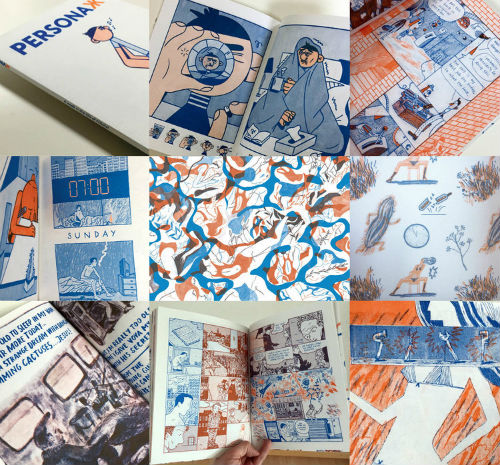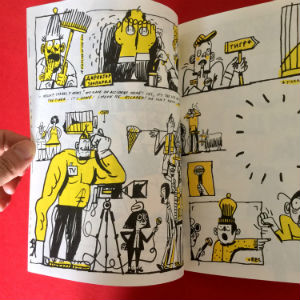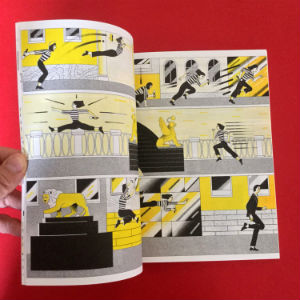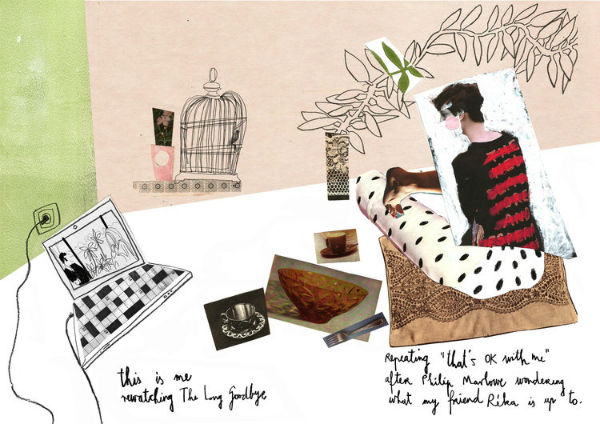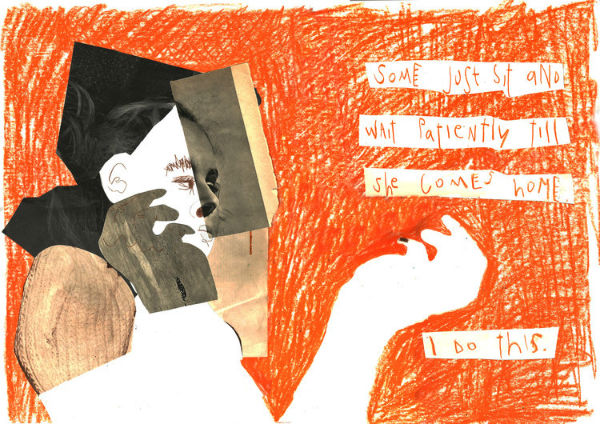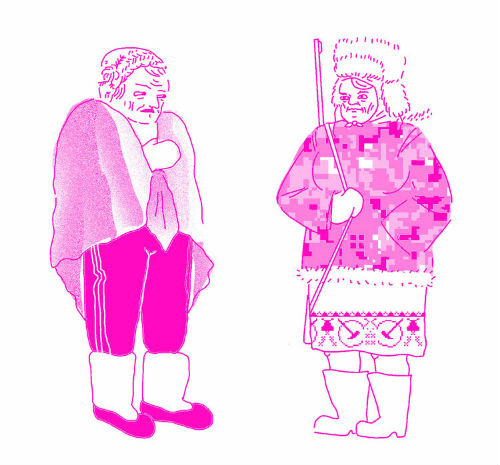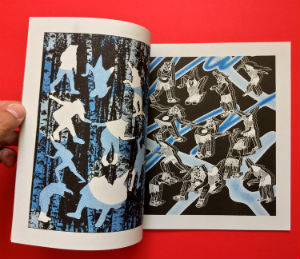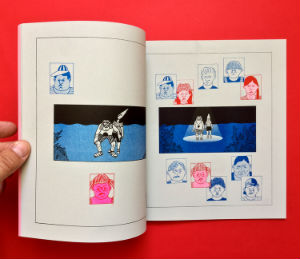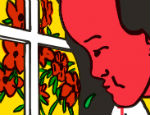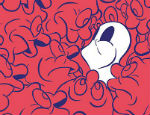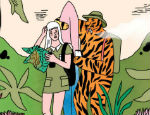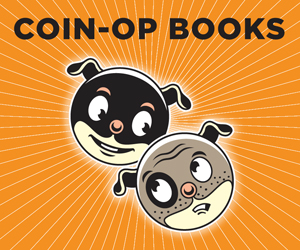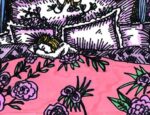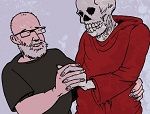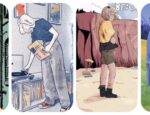ELCAF FORTNIGHT!
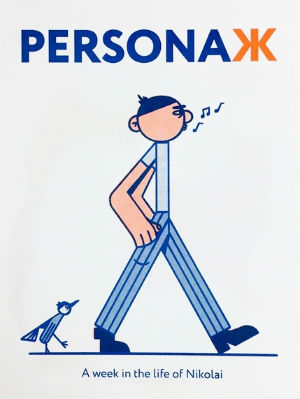 Russian micropublisher Sputnikat Press have featured a few times at Broken Frontier over the last couple of years. We’ve covered projects such as their ongoing PersonaЖ series of anthologies which follow one character through a week of their lives with seven different artists telling the story of each weekday. Last year we also reviewed Sari Szanto’s Sputnikat offering Housewife: What a Poor Lesbian Does When Her Girl Goes Away for the Weekend.
Russian micropublisher Sputnikat Press have featured a few times at Broken Frontier over the last couple of years. We’ve covered projects such as their ongoing PersonaЖ series of anthologies which follow one character through a week of their lives with seven different artists telling the story of each weekday. Last year we also reviewed Sari Szanto’s Sputnikat offering Housewife: What a Poor Lesbian Does When Her Girl Goes Away for the Weekend.
With comics that have an experimental edge and the potential to introduce readers to exciting new international voices, Sputnikat are a micropress to keep a close eye on. Ahead of their ELCAF appearance I chatted with Sputnikat founder Christopher Rainbow about how comics are perceived as an art form in Russia, bringing new creators to wider audiences, and what we can expect from Sputnikat in the future…
ANDY OLIVER: How did Sputnikat Press come into being and how would you describe its publishing mission?
CHRISTOPHER RAINBOW: Sputnikat came after I had been living and working (teaching Illustration) in Moscow for around 6 years, and I came to a point whether I should maybe leave Russia, or find some new project to focus on. I wanted to publish my own comics, and through being in Moscow, I knew that there were some special talents here that deserved to be published and wider known. So I bought a Risograph from Ukraine, and started with our first anthology, Personaж, and we’ve gradually progressed from there.
Principally, we’re representing interesting artists in or around the Moscow scene who are interested in visual storytelling. This year we moved the operation out of my flat and into a studio space which doubles as a shop and place for tiny exhibitions. Having a more public base has definitely given us the feeling of moving onto the next level. We’re located in a brilliantly strange location, Izmailovsky Market, which is a souvenir and flea market housed in this kind of giant Russian Disney castle. It’s strange, kitsch and grimy, so we feel perfectly at home.
The many differing approaches to the page in the first PersonaЖ
AO: How are comics as a form regarded in Russia? How are they perceived there in the wider public consciousness?
RAINBOW: Comics in Russia have less of a history than in most European countries. Essentially, the period of comics growth in the US and Europe coincided with Soviet Union, and comics were seen as both lowbrow and specifically American, so there wasn’t much comics action going on during that whole period. Consequently, the general public here are even less cognisant of the potential (never mind the reality) of comics as a medium of serious artistic merit. However, things are changing. Now, there are plenty of great comics from overseas translated into Russian. Also, my students get very enthused by the potential for telling stories once they start to get exposed to the range and depth of the good stuff.
And, I suppose that my disappointment at landing in a country with scant comics history is tempered by the feeling that there’s a great opportunity here to help define what Russian comics might be.
Art from the second issue of PersonaЖ featuring a week in the life of TV reporter Daria by Russian artists Irina Troitskaya and Katya Dorokhina
AO: The narrative style of your flagship PersonaЖ anthology is very distinctive in its approach. What was the thinking behind structuring your multi-creator anthologies in that way?
RAINBOW: It seemed obvious that our first book should be a collection of artists, and I wanted to find a format that would feel different and would appeal to me as a reader. Actually, the idea for PersonaЖ, to have a team all working with the same character, came quickly. It was one of those ideas that just arrive fully formed. I think it’s also interesting for the artists, a different kind of brief to work with; and it’s rather satisfying to collectively give birth to a new character.
AO: How would you describe Hungarian creator Sari Szanto’s mini-comic Housewife: What a Poor Lesbian Does When Her Girl Goes Away for the Weekend (above and below) and how did the project come to Sputnikat?
RAINBOW: Sari is a good friend and a creator that I have great belief in. She has developed a unique visual approach, through collage, and her writing is always humorous and intelligent, but it’s never flashily clever. I always feel like she has empathy with her characters and her text taps into their voice. Housewife was a tiny self-published zine that Sari did back in 2015. I always liked the story – it’s witty and warm, and about feeling adrift and useless at home when a loved one goes away.
I was also impressed by how Sari lightly weaves a political thread into the story. In Russia, conservative propaganda often attacks gay people by portraying them as hypersexual, so it feels important to have stories like this that are talking about a gay relationship in terms of companionship and everyday, almost mundane love. Although I liked the original mini-comic, I felt that Sari’s visual language of collage and spidery line work had already developed a lot since she did that zine, so we agreed for her to remake it for the Sputnikat edition.
AO: The latest PersonaЖ is almost entirely Russian in creative line-up. Who are some of the names involved that you’re bringing to wider audiences with this third edition of the project?
RAINBOW: Yes, as it turned out, everyone in PЖ3 is Russian, except for Sari. Evgenia Barinova is a illustrator based in Moscow, and also appeared in PЖ1. Comics aren’t her passion, but the work she’s done with us so far has turned out so well, I hope we can convince her to do some more stories. Dmitry Izotov works as a graphic designer, but I found his illustrations through Tzeh, a Russian illustration collective/directory. His drawings astound me, they are so intricate and charming; but what most impresses me is that more than any illustrator I’ve seen, he captures the details and feeling of living in Russia. If you live here and know the country, it’s a real joy to pore over his characters and locations and see all kinds of recognisable and well-observed features.
The third issue of PersonaЖ follows a week in the life of “tough, independent babushka Kontraflora”
Anna Sarukhanova is another Moscow illustrator, who works with screen printing a lot, so she also really understands how Riso works. She has an acerbic sense of humour in her storytelling that I love. Anna’s just started her own micro press, Neploho (‘not bad’) but I’m hopeful that we’ll publish a solo book from her on Sputnikat in the next year or two. The other two are Russian emigrees, and quite well established in their field. Roman Muradov lives in San Francisco, and he’s pretty well known as a cartoonist and commercial illustrator in the States.
Olesya Shchukina is from St Petersburg, but lives in Paris and she’s a fantastically talented animator. This was her first comic, hopefully it’s whetted her appetite to try more.
AO: Given the boundary-pushing nature of your comics in PersonaЖ, Housewife and books like Kameeellah’s Gopnik Walk With Me (above and below right), it would seem that experimental storytelling is a very important part of your ethos. Is that a fair observation?
RAINBOW: Yes, that’s a fair statements and the other contemporary comic artists that inspire me, from around Europe and the US also tend to be those who are exploring new approaches to visual storytelling. However, it’s not experimentation for the sake of it. I’ve always been attracted writers who have a distinctive writing style, rather than prioritising plot, and I think that it’s the same with comics. When I see this kind of artist finding new, idiosyncratic ways to visually communicate, it just reminds me how much untapped diversity there is in comics in terms of different ways to write with imagery. Perhaps we also get such work from our artists because most of them haven’t particularly grown up entrenched in comics culture, so they’re approaching it from a fresh perspective.
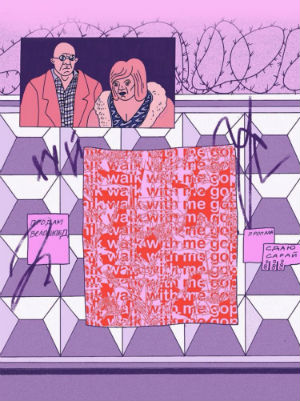 AO: As a micropublisher what have been the particular challenges for you in getting your work out to wider potential readerships?
AO: As a micropublisher what have been the particular challenges for you in getting your work out to wider potential readerships?
RAINBOW: Generally, there’s four ways that we sell our books – at festivals and book fairs, in Moscow at our studio/shop, online, and through shops. They all come with different challenges. Visiting comics or art book events around Europe is the most fun, and we’ve met a very receptive audience; but of course, these events come with travel costs and table fees. In Moscow, we opened up our studio as a shop, and it’s helped to spread the word, but we mainly get visitors and sales from our monthly mini-exhibitions. We often get people wandering into the shop and being utterly baffled by our books and the unusual look of our space. It’s quite different from any other space in Moscow.
Online, we just occasionally get orders, and with shops, we are quite careful about where we sell our books, because with our production costs, after the shop takes their slice, we don’t make any profit really. So, each variant is a struggle really, but to look at things positively, it still feels like we’re growing and that it’s worthwhile keeping at it to see where we can take it.
AO: What can readers expect to see from you next? What new projects are you putting together from via Sputnikat? And what should readers be looking out for at ELCAF from you?
RAINBOW: We’ve got plenty bubbling away. For ELCAF, we’ll be bringing City Garden (below) by Charlie O’Konar and Chill Pill by Katya Dorokhina. We’re also working on a series called Risunki, which will be small books collecting drawings by various Russian illustrators and cartoonists. The first three editions will be by Dmitry Izotov, Olesya Schukina and Pavel Grishin, who were all in Personaж 3. Pavel is also working on a comic for us that he says is something around the idea of “BDSM Dostoevsky”. Really looking forward to seeing and printing that one! We have a couple of books by new artists Natasha Savinova and Ilia Shatokhin, that will be beautiful and charming; and bizarre and disturbing, respectively. And I’m currently discussing ideas with Sari and Kameeellah about their next books.
In autumn, we’ll finally finish World Cup Journal, which is a joint-project between me and fellow Moscow-based Englishman, William Goldsmith, and that will be a collection of one page reportage comics documenting the experience of the World Cup in Russia last year. We’re both football fans, but the stories are more like little vignettes about people, the influx of people from around the world and small observations that intrigued or amused us.
And of course, PersonaЖ is also on its way, due for release in September. This one will be around a misanthropic chap called Boris and the artist team is a UK/Russia/Latvia/Brazil combo. It will feature stories from myself and Kameeellah, plus Masha Krasnova- Shabaeva, Liam Cobb, Jay Daniel Wright, Zane Zlemesa and Fabio Zimbres.
Sputnikat Press are exhibiting at ELCAF. For more on their books check out their site/online store here.
For more on ELCAF 2019 visit the festival site here and follow them on Twitter here.






